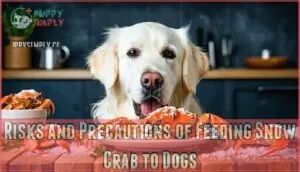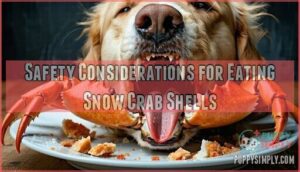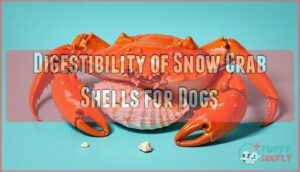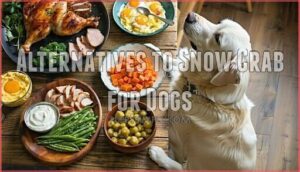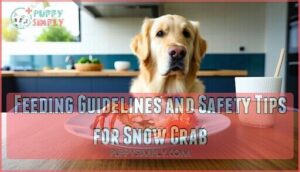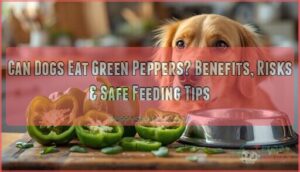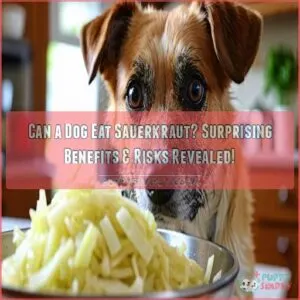This site is supported by our readers. We may earn a commission, at no cost to you, if you purchase through links.

You’ll need to remove all shells and cartilage since they’re choking hazards and can cause intestinal blockages.
The meat itself provides protein and omega-3 fatty acids, but it’s high in sodium and cholesterol, so moderation is key.
Never feed raw crab due to parasite risks, and skip any seasoning or butter that often comes with prepared crab dishes.
While snow crab isn’t toxic to dogs, it’s more of an occasional treat than a regular meal component.
There are specific preparation methods and portion guidelines that can make this seafood safer for your four-legged friend.
Table Of Contents
Key Takeaways
- You’ll need to remove all shells and cartilage completely – they’re serious choking hazards that can cause intestinal blockages and internal injuries to your dog.
- Only serve plain, cooked white meat in small portions – raw crab carries parasite risks, and seasoning or butter can be toxic to dogs.
- Limit snow crab to an occasional treat, not regular meals – it’s high in sodium and cholesterol, so moderation is key for your dog’s health.
- Watch for allergic reactions when introducing crab – start with tiny amounts and monitor your dog for signs of seafood sensitivity before giving more.
Can Dogs Eat Snow Crab?
Yes, dogs can eat snow crab safely when properly prepared.
The key is serving plain, cooked crab meat without shells or seasonings.
Snow crab offers excellent crab nutrition including protein and omega-3s, but pet safety requires caution.
Some dogs may develop dog allergies to seafood, so introduce gradually.
Remove all shells completely to prevent choking hazards.
Consider fish alternatives like plain chicken if your dog shows sensitivity.
Always prioritize dogs eating seafood responsibly through proper crab preparation.
Risks and Precautions of Feeding Snow Crab to Dogs
While snow crab can be a nutritious treat for dogs, it comes with several important risks you need to understand before sharing it with your furry friend.
Raw crab and sharp shells pose the most significant dangers, requiring careful preparation and feeding practices to keep your pet safe.
Raw Snow Crab and Parasite Risks
Raw snow crab poses serious parasite control challenges that every dog owner should understand. When you’re wondering "can dogs eat crab," the answer depends heavily on proper preparation.
Raw crab meat toxicity stems from harmful organisms like Neoparamoeba perurans and various protozoan parasites that thrive in uncooked seafood. These parasites can cause severe food poisoning in dogs, leading to vomiting, diarrhea, and potentially life-threatening complications.
Raw meat risks aren’t worth taking when it comes to crab safety and your dog’s health. Studies show that raw crab harbors intestinal parasites at rates of 3-5% in some populations, making seafood toxicity dogs face a real concern.
Smart pet parents cook crab thoroughly to eliminate these dangerous organisms. Proper cooking destroys parasites while preserving the nutritional benefits your dog can safely enjoy. Remember, to prevent these issues, proper cooking is key. It’s vital to follow crab feeding guidelines to guarantee your pet’s safety and well-being.
Potential Injuries From Snow Crab Shells
Beyond parasite concerns, snow crab shells present serious physical dangers that shouldn’t be overlooked. These hard shells create multiple choking hazards when dogs attempt to swallow them whole or in large pieces. Shell splintering occurs easily, producing razor-sharp fragments that can lodge in your dog’s throat or digestive system.
Snow crab shells turn into dangerous razor blades in your dog’s digestive system.
The sharp edges of broken shells cause significant shell injuries throughout the digestive tract. These fragments can puncture the mouth, esophagus, stomach lining, or intestines, leading to bleeding and potential infection. Even small pieces pose substantial gastrointestinal risks as they scrape internal tissues during passage.
Intestinal blockages represent another serious concern when dogs consume shell pieces. These indigestible materials can accumulate and obstruct the digestive tract, requiring emergency surgery. Dental damage also occurs when dogs attempt to crunch through tough shells, potentially cracking teeth or causing gum injuries.
Complete shell removal before serving crab meat eliminates these risks entirely. Never assume your dog can safely process shells – proper preparation prevents potentially life-threatening complications. It’s vital to understand dog safety guidelines to guarantee your pet’s well-being when consuming seafood.
Benefits of Snow Crab Meat for Dogs
While snow crab carries risks, it also offers impressive nutritional benefits when prepared correctly.
This protein-packed seafood can be a healthy addition to your dog’s diet when served safely.
Snow crab delivers high-quality protein sources that support muscle development and repair.
The lean meat provides essential amino acids your dog needs for ideal health.
What makes this seafood special is its impressive nutrient boost – it’s loaded with vitamin B12 for red blood cell production and zinc for immune system support.
The omega benefits are particularly remarkable.
Snow crab contains omega-3 fatty acids that promote healthy skin and coat while reducing inflammation.
These same fatty acids support heart health and may help with joint discomfort in older dogs.
For dog nutrition enthusiasts, snow crab offers selenium and copper – minerals that boost immune function.
The low-fat content makes it ideal for weight management, while the high protein supports energy levels.
When asking "can dogs eat crab," remember that crab legs for dogs should always be shell-free.
Snow crab safety depends on proper preparation, and understanding crab nutrition facts helps you make informed decisions about adding seafood for dogs to their meals.
Can Dogs Eat Snow Crab Shells?
While snow crab meat offers nutritional benefits for dogs, the shells present serious safety concerns that pet owners must understand.
You should never allow your dog to eat snow crab shells, as they pose significant choking hazards and can cause dangerous intestinal blockages.
Safety Considerations for Eating Snow Crab Shells
Regarding snow crab shells, the risks far outweigh any potential benefits. Crab shells are hard, sharp, and brittle—creating a perfect storm of choking hazards for your dog.
These jagged fragments can lacerate your pet’s mouth, gums, and throat, causing immediate pain and bleeding. Shell removal isn’t just recommended—it’s absolutely essential.
Even small pieces can accumulate in your dog’s digestive system, leading to serious intestinal blockage that may require emergency surgery. The sharp edges can puncture stomach or intestinal walls, allowing bacteria to enter the bloodstream and cause life-threatening complications.
Beyond physical injuries, crab shells pose additional risks. Raw shells may harbor parasites, while seasoned shells contain toxic additives like garlic and onion. Dogs with shellfish allergies face even greater dangers, as shells can trigger severe reactions.
The bottom line on snow crab safety? Complete shell removal is non-negotiable. Unlike crab legs for dogs (which require careful preparation), shells offer zero nutritional value while presenting maximum risk. In the context of seafood toxicity affecting dogs, why gamble with your pet’s health? Ensuring proper dog food safety is vital to prevent such risks.
Digestibility of Snow Crab Shells for Dogs
Understanding shell digestibility helps you make informed decisions about your dog’s safety.
Dogs possess extremely limited chitinase enzymes, meaning they can’t break down chitin—the primary component of snow crab shells.
This creates several serious risks:
- Sharp shell fragments acting like tiny knives in your pup’s mouth and throat
- Indigestible particles accumulating in the intestines like roadblocks
- Choking hazard from larger shell pieces getting stuck
- Gastrointestinal distress causing painful cramps and potential blockages
The shell particle size doesn’t matter—whether large chunks or small fragments, your dog’s digestive system can’t process them.
Shell mineral content offers zero nutritional benefit since the chitin remains intact throughout digestion.
These shells create serious intestinal blockage risk, potentially requiring emergency surgery.
To help ease discomfort, consider administering antacids following ingestion.
Instead of gambling with shells and cartilage, choose safe shell alternatives like plain cooked crab meat.
Remove every bit of shell before serving to prevent digestive issues and keep your furry friend happy and healthy.
Alternatives to Snow Crab for Dogs
When your dog needs protein beyond crab, countless safe alternatives exist.
Lean meat like chicken and turkey provides high-quality protein without shellfish risks.
These options offer excellent nutrition while being gentler on your pet’s digestive system.
Consider these dog-friendly protein sources:
- Fish options – Salmon and whitefish fillets (cooked, deboned) deliver omega-3s without shell dangers
- Egg benefits – Scrambled or hard-boiled eggs provide complete amino acids and easy digestion
- Yogurt probiotics – Plain, unsweetened yogurt supports gut health with beneficial bacteria
- Safe vegetables – Carrots, green beans, and sweet potatoes add fiber and vitamins to dog food recipes
These alternatives work well for dogs with dog seafood allergy concerns.
Unlike processed seafood products, these lean protein sources contain controlled sodium levels.
You can easily incorporate them into homemade safe foods for dogs recipes.
Many owners also explore dog food alternatives to find the best fit for their pets.
Remember to introduce new proteins gradually – your dog’s stomach will thank you for the careful shift.
Feeding Guidelines and Safety Tips for Snow Crab
While safer alternatives exist, you can offer snow crab to your furry friend when following proper crab feeding guidelines. Start with small portions—1 tablespoon per 10 pounds of body weight—and watch for dog seafood allergy symptoms like itching or vomiting.
Safe preparation requires attention to detail:
- Shell removal: Remove every fragment to prevent choking hazards and internal injuries
- Cooking methods: Steam or boil thoroughly to eliminate harmful bacteria and parasites
- Portion control: Limit servings to once or twice weekly to avoid sodium overload
Cook plain snow crab without seasonings, as garlic and onions are toxic to dogs. Monitor your pet closely after introducing this shellfish treat. If you notice any adverse reactions, contact your veterinarian immediately. Remember, crab nutrition shouldn’t replace your dog’s regular diet—it’s simply an occasional protein boost when prepared safely.
Frequently Asked Questions (FAQs)
Can dogs eat crab?
Before GPS systems ruled the road, you’d need to carefully introduce cooked crab meat to your dog’s diet.
Yes, dogs can eat plain, thoroughly cooked crab in small portions, but remove all shells first.
Can dogs eat soft shell crab?
Yes, dogs can eat soft shell crab in moderation.
It’s actually richer in omega-3s and B12 than hard shell varieties.
Remove any sharp fragments, cook thoroughly without seasonings, and serve small portions occasionally to avoid digestive upset.
Can dogs eat crab salad?
Nearly 75% of commercial crab salads contain garlic and onions, which are toxic to dogs.
You shouldn’t feed your dog crab salad because it typically contains mayonnaise, seasonings, and other ingredients that can upset their stomach or cause serious health issues.
Can dogs eat deep fried crab?
Deep-fried crab isn’t recommended for dogs.
The heavy batter, oil, and seasonings can upset their stomach and add unnecessary calories.
Stick with plain, cooked crab meat instead for a healthier treat.
Is crab meat poisonous to dogs?
Ironically, while crab meat isn’t poisonous to dogs, it’s the preparation that’ll get you in trouble.
Plain, cooked crab meat is safe in small portions, but seasonings, shells, and excessive sodium can cause serious health issues.
Can dogs eat imitation crab meat?
Dogs can eat imitation crab meat occasionally, but it’s not recommended.
This processed seafood contains high sodium, artificial additives, and preservatives that can upset your dog’s stomach and potentially cause health issues.
Can dogs eat cooked snow crab?
Yes, you can feed your dog cooked snow crab safely.
Remove all shells and cartilage first, serve plain without seasonings, and offer small portions occasionally.
Watch for allergic reactions and avoid overfeeding due to high sodium content.
What seafood should dogs not eat?
Like traversing treacherous waters, you’ll want to steer clear of raw shellfish, seasoned fish, and anything with bones.
Avoid salmon, mackerel, sardines with high mercury, plus any seafood containing garlic, onions, or excessive salt that could harm your furry companion, including those with garlic.
How much snow crab is safe daily?
Daily snow crab isn’t recommended for dogs.
Instead, limit portions to 1-2 tablespoons for small dogs or up to ½ cup for large breeds, served only once or twice weekly to prevent sodium overload.
Can puppies eat snow crab meat?
Notably, you’re asking about puppies when many pet parents wonder about adult dogs first.
Puppies shouldn’t eat snow crab meat due to their developing digestive systems, higher sodium sensitivity, and increased choking risks from shell fragments.
Conclusion
Remember Jake, the golden retriever who stole a whole snow crab leg from his owner’s dinner plate? Thankfully, his quick-thinking owner removed the shell before Jake could swallow it, preventing a potential emergency room visit.
While the answer to "can dogs eat snow crab" is yes, it requires careful preparation and moderation. Always serve only cooked white meat without shells, seasoning, or butter.
The high sodium content means it’s strictly an occasional treat, not a regular meal addition. When prepared safely, snow crab can be a protein-rich reward your dog will love.
- https://www.loudoun.gov/4155/Dog-Licenses
- https://www.onestudyteam.com/
- https://www.esccap.eu/link-document/135/
- https://eafpbulletin.scholasticahq.com/article/116257-no-evidence-of-_hematodinium_-spp-infections-in-the-recently-established-barents-sea-snow-crab-population
- https://pmc.ncbi.nlm.nih.gov/articles/PMC8455362/

